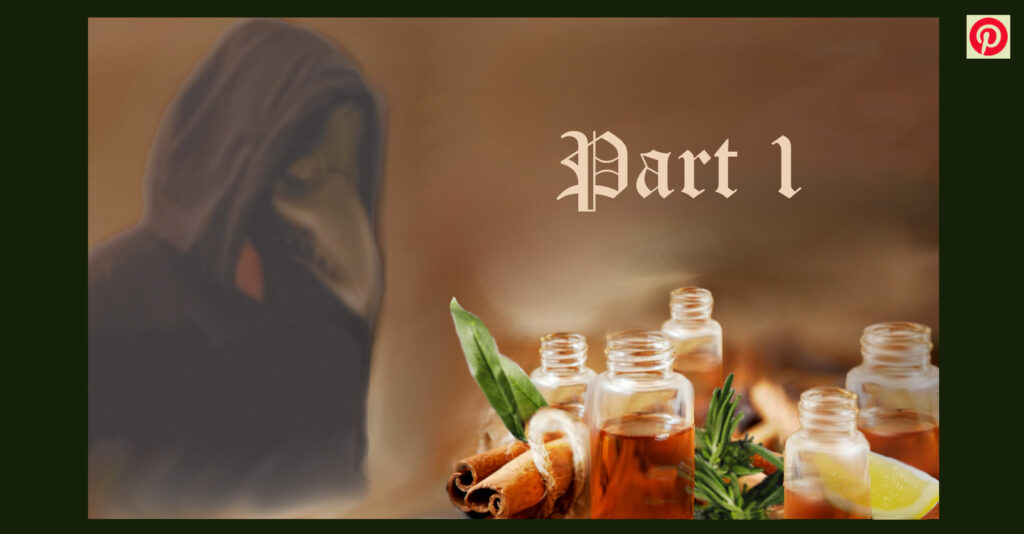The Four Thieves Oil (Part 1) – Its History
A lot of fanciful stories surround the origin of Four Thieves Oil. These tales are whimsical and intriguing and we all love a good story don’t we? (Oh, were you looking for the Four Thieves Oil blend? Then you want to go to Part 2!)

[This post contains affiliate links. If you make a purchase through one of these links I may earn a commission. This does not impact your price. For more information, please see our disclosure.]
In this Post:

Let me take you back in time…
A devastating epidemic is taking over the modern world. Ships that pull into harbor are filled with the dead or dying. The virus that swept these ships seems indiscriminate and the infection spreads rapidly among the general populous. The infected are well one day and then down the next with body-wrecking illness. News spreads that hundreds are dying daily.
People avoid locations which weeks or maybe even just days ago they comfortably visited. Neighbors who in the past stopped to chat now duck their heads and give each other wide berth. Doors remain closed as families huddle together inside, afraid to venture beyond that closed door. They question everything they buy—is it infected? Those who do venture out are struck by the empty streets and boarded up shops.
Doctors are scrambling to figure out how the illness is transmitted, how to prevent it, and how best to treat it. Strict 40-day quarantines are implemented. Fear is widespread. Everyone is vulnerable.(1)
Sounds awfully familiar, doesn’t it? Nope, it’s not 2020! These are the Black Death years of the late 14th and early 15th Centuries.
But you’re not here to be reminded of those early months of the coronavirus pandemic. You’re here because you want to learn about this amazing essential oil blend called the Four Thieves Oil.
[Or maybe you just want an essential oil recipe! If so, jump to my 5 Musketeers Blend in Part 2 of this story.]

The Four Thieves Oil History
An online search brings back hundreds of posts claiming the origin of the Four Thieves Oil blend dates back to the time of the Black Death, or bubonic plague.
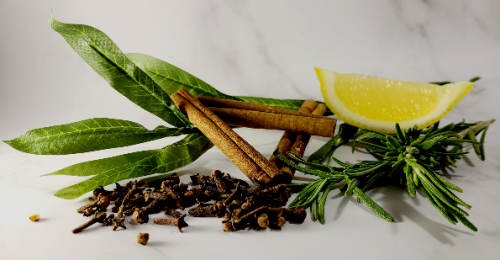
The story goes that four perfume and spice merchants, whose income evaporated due to the rapidly spreading plague, took it upon themselves to relieve the dead and dying of their possessions. Amazingly they never became ill.
These Four Thieves apparently doused themselves and the masks they wore with a blend of Cinnamon, Clove, Eucalyptus, Lemon, and Rosemary oils.
Let’s take a closer look at this story.
Only the Wealthy
At the time of the bubonic plague, so called perfumes would have been the purview of the wealthy and were most likely used medicinally. A wealthy or royal family would have had a “spicer” who was responsible for overseeing the aromatics used in the kitchens, and who would have also been responsible for creating aromatic waters and fumigating incense for the household.
Other aromatics could have come from physicians or apothecaries who would have used the available herbs and spices in compounded medicines.(2)
Essential Oils Uncommon
Essential oil distillation was still in its infancy at this time and it wasn’t until well into the 1500s that essential oils were in widespread use across Europe. So, while a few select essential oils might have been available during the years of the bubonic plague, chances are they were extremely limited and very costly and therefore unlikely to be used by our Four Thieves.
Pomanders for Protection
True, many people kept a bundle of strongly scented flowers at hand to protect against an assault of unpleasant odors. Among the nobles, these pomanders, a combination of highly aromatic resins, herbs, and spices, stored in ornate containers and amulets, were also crafted by the household’s spicer.
The idea was that contagions were spread via offensive odors and that inhaling a pleasant aroma would provide some protection from this miasma.(3) However…
Lack of Availability
Just the availability of these particular herbs and spices used in the Four Thieves Oil blend would limit access further.
Cinnamon and Clove were spices of the wealthy, expensive imports from Asia via the Middle East. Eucalyptus is grown in Australia, a country not yet “discovered” at the time of the bubonic plague. And Lemons were an ornamental garden plant, rarely grown outside of a few Mediterranean European cities.
Out of all of these Four Thieves Oil ingredients, Rosemary is the only herb that was widely in use across Europe at the time.(2,4) They could certainly have used an herb infused Rosemary oil, or…
Was it a Vinegar?
It’s possible that the original blend was actually a vinegar. By the Middle Ages vinegar was used widely as a wound cleanser, so this would make more sense. However, Cinnamon, Clove, Eucalyptus, and Lemon were likely not part of that blend. Instead, Rosemary, Sage, Thyme, Garlic, and Onions would have been more probable ingredients. (Sounds like a start to a delicious vinaigrette, to me!)
And Lastly, No Plague Masks
The beaked plague masks we so often associate with the so called Black Death “plague doctors” didn’t actually appear until the 17th Century in France and Italy.(3)
Does the Four Thieves Oil origin story, now spread far and wide across the internet, seem historically accurate?

To me, no. If our Four Thieves had regular access to these expensive and rare ingredients, why would they use them in this way? Why not sell them to the wealthy? That seems a safer and potentially more lucrative alternative than exposing themselves to the highly contagious bubonic plague. Hmmm…

So Then, Why These Oils/Herbs?
The claim of immune boosting, air cleansing, and energizing properties of this combination of oils definitely has merit. In fact, I love the combination of these oils for air freshening (especially when someone is sick), surface cleaning, and floor mopping. Here’s why.
The Spices
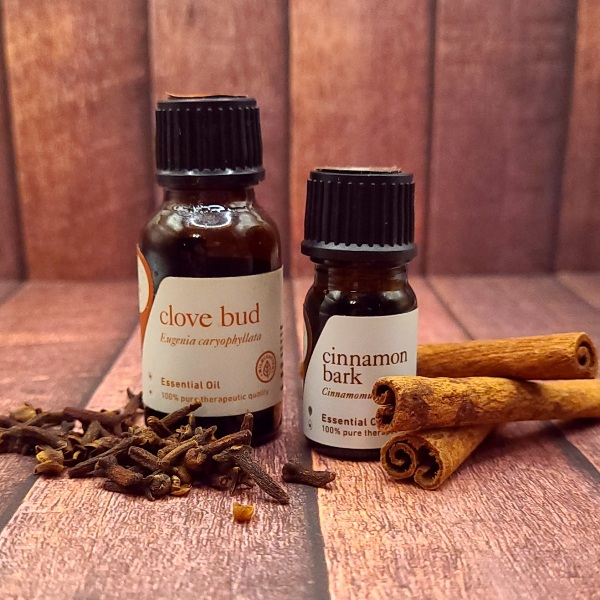
Cinnamon bark essential oil is warm and energizing, inspiring creativity. Its spicy, sweet, and slightly floral aroma is deodorizing and purifying. Rich in the phytochemical cinnamaldehyde, Cinnamon Bark is also a very good essential oil for cleaning.(5)
Clove bud, another aromatically warm and comforting essential oil, stimulates positive energy and positive thinking. It’s chemical composition, in particular the phytochemical eugenol, indicates the ability to combat microbes, especially when combined with Rosemary.(5,6)
🌺See my Recommended Suppliers below
The Herbs
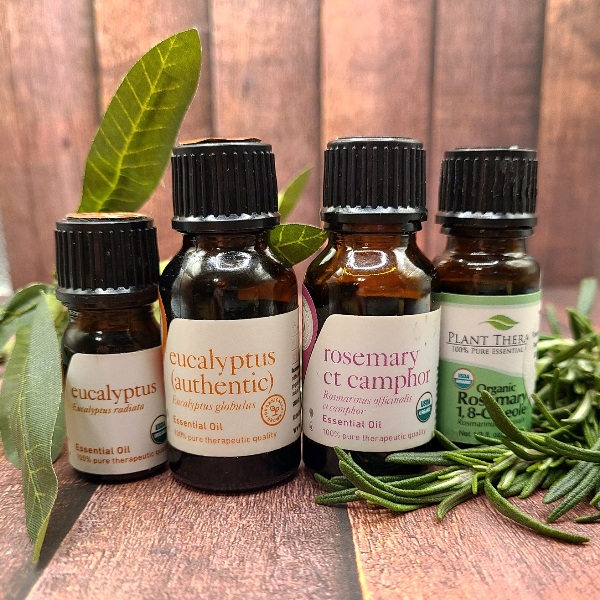
Shakespeare called Rosemary the herb of “remembrance.” Fresh and herbaceous, Rosemary essential oil stimulates the mind, the imagination, and the ability to focus. The aroma opens the breath and helps reduce stress. As an essential oil with antimicrobial properties(7,8), I love including it in my air freshening and surface cleaning blends. I recommend either Rosemary camphor or 1,8-cineole chemotype for a Four Thieves Oil blend.
Eucalyptus essential oil is refreshing, energizing, and stress reducing. Like, Rosemary, Eucalyptus clears the mind and enhances the ability to focus.(8) Its 1,8-cineole content helps ease congestion and encourages deep breathing. This phytochemical is also responsible for Eucalyptus’ antimicrobial action.(9)
I recommend using either Eucalyptus globulus or Eucalyptus radiata in a Four Thieves Oil blend as these contain significant 1,8-cineole and the aroma of these species of Eucalyptus blends well with the other oils.
🌺See my Recommended Suppliers below
And The Citrus
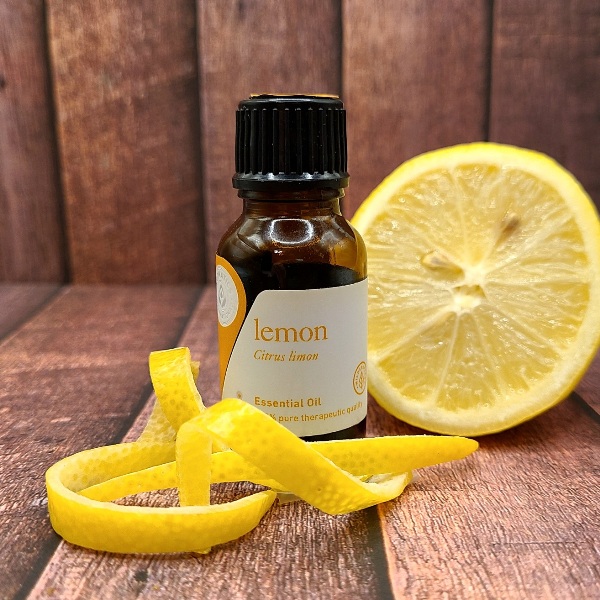
Lemon essential oil is energizing, uplifting, and tension-reducing. When inhaling the aroma you may experience a feeling of expansion, as stress is dissolved to replaced by a relaxed outward energy.
Look on any shelf in the cleaning aisle of your grocery—it will be filled with “lemon” products. Well-recognized as an effective cleaning agent, lemon’s uplifting aroma also makes you feel good while cleaning!
🌺See my Recommended Suppliers below
In Part 2 you’ll see how to combine these essential oils to create your very own Four Thieves Oil blend!
Or, if you just want to purchase a pre-made blend, check out suggestions below.

References
- History.com Editors. (2021). Black death. https://www.history.com/topics/middle-ages/black-death
- McBride, N. (2021). The sketchy history of four thieves oil. The Death Scent Project. https://deathscent.com/2021/08/01/the-sketchy-history-of-four-thieves-oil
- Black, W. (2020, May 19). Plague doctors: separating medical myths from facts. All About History. https://www.livescience.com/plague-doctors.html
- Grivetti, L.E. (n.d.). Rosemary. Nutritional Geography, University of California, Davis. https://nutritionalgeography.faculty.ucdavis.edu/rosemary
- Hili, P., Evans, C.S., Veness, R.G. (1996). Antimicrobial action of essential oils: the effect of dimethylsulphoxide on the activity of cinnamon oil. Lett Appl Microbiol, 24(4):269-75. https://doi.org/10.1046/j.1472-765x.1997.00073.x
- Chaieb, K., Hajlaoui, H., Zmantar, T., Kahla-Nakbi, A.B., Rouabhia, M., Mahdouani, K., Bakhrouf, A. (2007). The chemical composition and biological activity or clove essential oil, Eugenia caryophyllata (Syzigium aromaticum L. Myrtaceae): a short review. Phytother Res, 21(6):501-6. https://doi.org/10.1002/ptr.2124
- Nieto, G., Ros, G., Castillo, J. (2018). Antioxidant and antimicrobial properties of rosemary (Rosmarinus officinalis, L.): a review. Medicines (Basel, Switzerland), 5(3):98. https://doi.org/10.3390/medicines5030098
- Tisserand, R. (2012). Rosemary boosts brain power! https://roberttisserand.com/2012/03/rosemary-boosts-brain-power
- Tine, Y., Diallo, A., Ndoye, I., Gaye, C., Ndiaya, B., Diop, A., Costa, J., Bouh Boye, C.S., Wele, A., Paolini, J. (2022). Chemical variability and antibacterial activity of Eucalyptus camaldulensis essential oils from Senegal. Int J Org Chem, 12(4):173-80. https://doi.org/10.4236/ijoc.2022.124014

Mom’s Shopping List
Ready to make your own version of this effective blend? Here are my recommended suppliers for the 5 essential oils used in standard Four Thieves oil blends.
- Pre-Made Four Thieves Oil Blends:
- Aromatics International‘s Mountain Bandits blend
- Plant Therapy‘s Germ Fighter blend
- Edens Garden‘s Fighting Five blend (on Amazon)
- Cinnamon Bark essential oil (Cinnamomum verum/C. zeylanicum/C. cassia):
- Aromatics International, organic
- Plant Therapy, organic (Direct and Amazon).
- Clove Bud essential oil (Eugenia caryophyllata/Syzygium aromaticum):
- Aromatics International, sustainably wildcrafted
- Plant Therapy, organic (Direct and Amazon).
- Eucalyptus globulus essential oil:
- Aromatics International, organic
- Plant Therapy, organic (Direct and Amazon).
- Lemon essential oil (Citrus x limon):
- Aromatics International, organic
- Edens Garden, sustainable (on Amazon)
- Plant Therapy, organic (Direct and Amazon).
- Rosemary essential oil (Rosmarinus officinalis / Salvia rosmarinus):
- Aromatics International, organic, Rosemary camphor and Rosemary verbenone
- Edens Garden, sustainable, “Spanish” Rosemary camphor (on Amazon)
- Plant Therapy, organic, Rosemary 1,8-cineole (Direct and Amazon).
This information has not been evaluated by the Food and Drug Administration and is not intended to diagnose, treat, cure, or prevent any disease. It is for educational purposes only.
All recipes provided are for personal use and are not designed for re-sale or large-scale manufacturing.
Please consult your doctor, naturopath, herbal practitioner, or other qualified health professional for medical advice and before starting any herbal regimen, particularly if you are pregnant or nursing, have any existing medical conditions, or are taking any medications.
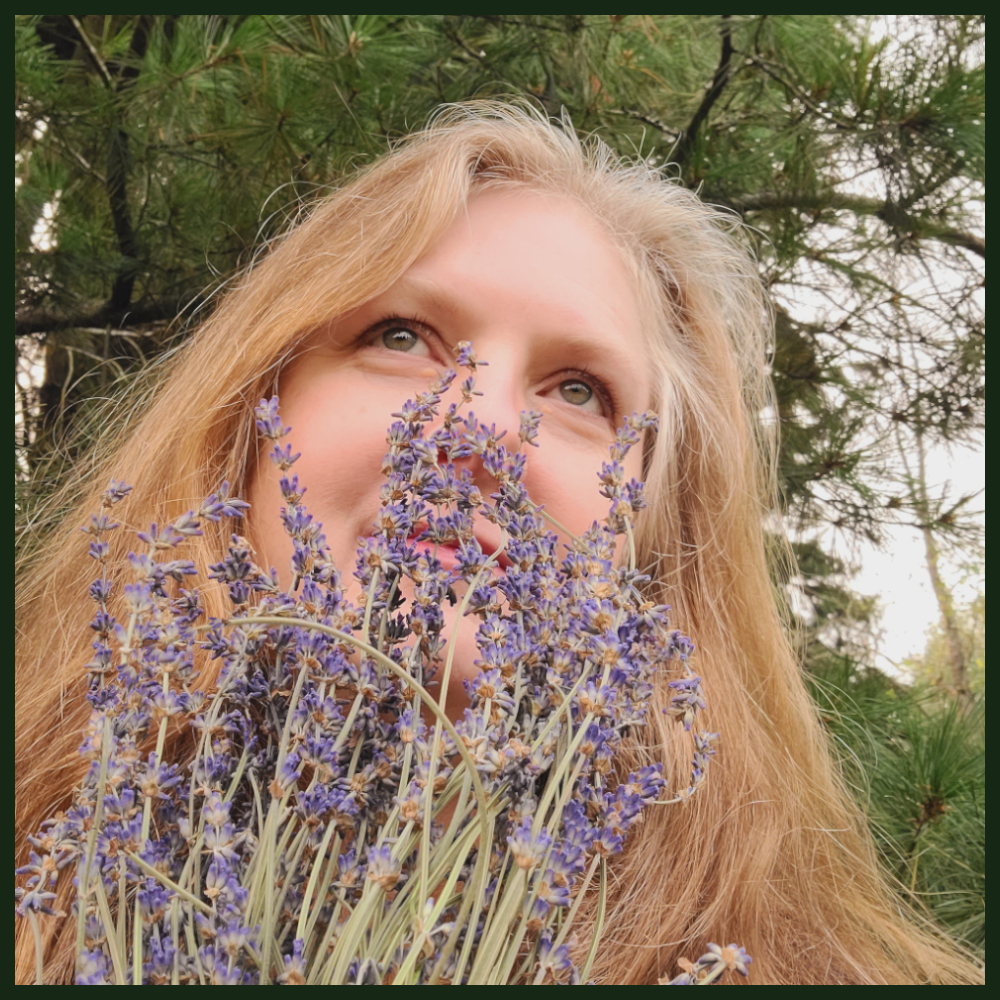
Chris P | Author, Certified Aromatherapist, Natural Skin Care Formulator
Chris (“Mom”) enjoys formulating bespoke aromatherapy, skin care, and herbal products to support her family, pets, friends, and clients. She also loves experimenting with recipes in the kitchen. An avid reader, writer, and lifetime learner, Chris enthusiastically explores research rabbit holes and then writes about her discoveries.💚 (Learn more >>)

